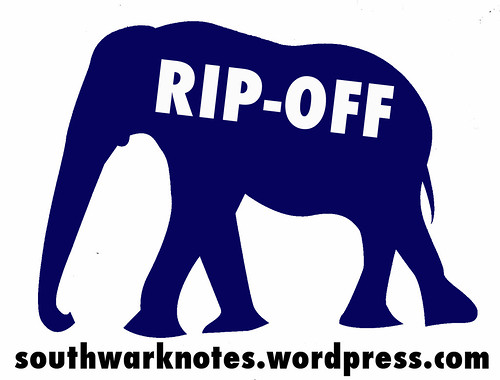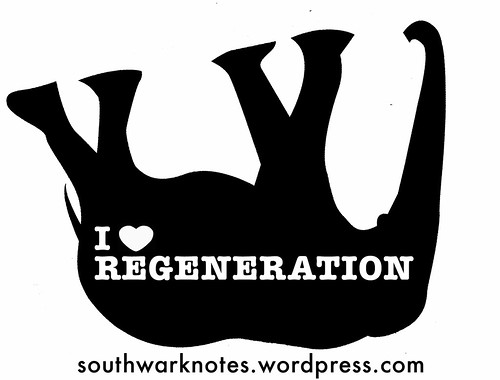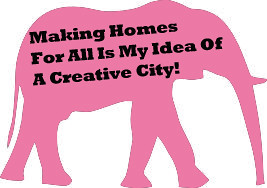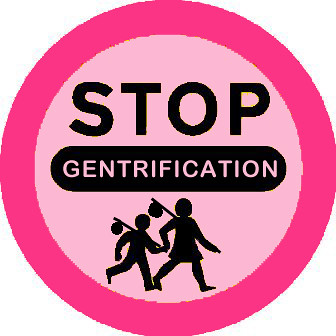REFUSAL of REGENERATION
The regeneration of the Elephant & Castle has been a long time coming. Some people can’t wait for it and other people hope it never happens. Various phases come and go from flurries of activity, glossy brochures and consultations that are soon then followed by delays, deceits and downright scandalous behaviour. Those of us who have lived through this long history maintain a long memory for these eternally returning negativitities in our area.
In the first failed round of regeneration up to 2002, the then Council Director of Regeneration Fred Manson famously upset local residents with his idea that the large number of poor people in The Elephant meant that ‘the middle classes stay away’. He then added that the problem of the area was that it ‘was full of the wrong sort of residents’. If we fling ourselves forward again to the year 2011, we can hear Rob Deck, LendLease Project Director of The Elephant regeneration say to a Liaison Group meeting that ‘The Elephant & Castle has no soul..there is no community here’. This is the same statement as Fred Manson’s above but cast in a less feral way. What Rob is saying is that LendLease cannot detect a heart and soul amongst us poor types because the area is not full of new build private housing and chain stores and destination shops (i.e shops that pull people into the area). What this fails to understand and regeneration developers will always either fail to see this or not really care in the first place is that poor local areas such as The Elephant are rich in micro-communities that live side by side with each other in a mostly harmonious and common-sensical way. If you walk around the area you will see a wide range people doing things that are what most people in this area do. They live in local houses and flats, they shop in local shops, they hang out in local streets and parks and they eat, drink and amuse themselves in local caffs, pubs, takeaways and restaurants – The Red Lion, The Tankard, Wetherspoons, Café Time, Café House, Ranya, The Noodle Bar, Dragon Castle, Best Kebab, the Ivory Arch, La Bodeguita, Mamoya and so on. The area is not ‘vibrant’, ‘exotic’ or ‘cool’. It is what it is and has been for a long time – a sustained organic fabric of different communities that grow up alongside each other and exist within the mostly affordable services and amenities that the area offers. That these shops and other places exist is because of the population in the first place here and now and not any other external reason. This is the heart and soul of the area – those million tiny daily interactions that are invisible to developers because otherwise the developers could not then pretend that the area was a blank slate to fill with some kind of artificial heart.
It is not chain stores or fancy shops, hotels and coffee shops, bars and hip places, or maybe conference facilities and hotels that will bring a heart and soul to the area. The attraction of people to the area on a temporary basis and the influx of commercial activity to cater for those people will not be something organic and livable. It will be a recreation of every other badly planned and badly developed parts of London pretending that such development whose soul is based on making money will provide a missing heartbeat here too.
It’s what is already here that is the community. At Southwark Notes, we don’t need to even walk the streets to detect what this heartbeat might mean economically and culturally for the area. We can write up a list from the top of our heads: the African guys hanging at night outside at Malata mini-market and going absolutely crazy during the World Cup; Domino players outside the Elephant market’s Caribbean food kiosk with the slap, slap, slap of the pieces; Karaoke at The Tankard Friday Nights to hurt your eardrums and musical sensibilities, maybe?; Kids and mums and dads at St Mary Newington in the new playground spinning round; Caff culture and all the conversations and the food from egg roll and chips to hot pepper soup to kebab and salad / time-tested East St market, never-changing, ever changing; Baldwins on Walworth Rd in the Herbal side where conversations between customers on ancient remedies for ancient ailments abound; Football on the big screen and Irish music in The Red Lion, Brazilian music in the newish Banana bar; Drunken people gathering outside Morrisons on the public chairs cheek by jowl next to the occasional God botherers of all varieties…
What we have here locally covers all the bases for what you need. If you want something fancy then the West End is a bus ride away. It’s somewhat amazing to think that developers and The Council can imagine that branches of Tescos, Gap, H+M, Costa Coffee, Starbucks, Wagamama, Giraffe Café, Pizza Express or whatever could constitute a desirable ‘cultural identity’ over what we already have here.



REVITALISATION’s KISS of DEATH
You may have noticed the big mauve signs The Council have been sticking up everywhere that say ‘REVITALISE’ and end in a postcode such as REVITALISE17. This is the same notion that we are talking about above. If we decode the ‘Revitalisation’ motto we see that they are talking about bringing life back to an area as if all live had already been lost here. It’s no coincidence that we can see this motto at work across the world from Baton Rouge in the USA to Rio De Janeiro in Brazil to Walworth Rd in London for this is the accepted planning and developer speak for getting rid of the poor people because they don’t spend much on shopping and housing. Developers call this revitalization ‘adjusting the mix’ or ‘balancing the local’ but what they mean is getting rid of the ‘wrong sort of residents’.
“THIS COULD PROVIDE THE BASIS FOR A NEW VIBRANT CULTURAL IDENTITY FOR THE ELEPHANT & CASTLE” – LendLease
What would bringing Walworth Rd a little revitalising kiss of life mean? We outline some of our nightmares here.
It’s Bye Bye to the Shell Garage at the top end of Walworth Rd. It’s lease is up in November and so it will be saying goodnight and bon nuit! LendLease, the re-developers of The Elephant area are looking at the site for a Box Park-style temporary arty / foodie market (click the link if you have a strong (organic) stomach). Such a notion was expressed at a recent Lend Lease Liaison Meeting at The Hub on Walworth Rd. You can see some of LendLease’s ideas from their recent Interim Uses document:
BoxPark, as an inspiration, describes itself as “BoxPark is radical stuff. it’s not some run-of-the-mall shopping centre. It’s a living, fertile community of brands packed with talent, innovation and attitude that puts creativity and fashion back where they belong: on the street. BoxPark isn’t just where you shop. it’s an inspiring and enjoyable place to drop in and hang out. It’s what a real brand experience should be all about.” Etc ad nauseam. So it’s basically more niche shopping and the creation of a funky fun entertainment ‘creative’ zone for an area that has been pretty much free of such banal spectacles. ‘Creative’ must be the most overused word to disguise the imposed gentrification of formerly unfunky areas. It’s as if we must be either heathens or purely miserablists if we don’t support those ‘creatives types’ but we have our own funk in the area, as described above in our list, thank you. Always have and that’s what makes the area worth not filling with acres of hip shopping and cool bars like Brick Lane or Shoreditch.
It’s also about recognising that the area is incredibly mixed in terms of ages and what shopping, services and amenities all those ages can access. Areas which have been subject to the explosion of hipster shopping and foodie lifestylism are reduced down to one particular range of ages and incomes whereby the sainted 21 – 35 year old demographic get to enjoy their new playgrounds of artbars, coffee shops, clubs and boutiques and everyone else is pushed to the margins. Just walk down Shoreditch High St on the weekend and you’ll see this age range running free. It certainly isn’t very pleasant, considerate or inviting. Not cool, I’m afraid. Is this really what local people want for the Elephant area?
We added our own brand to this one…
THE USUAL GENTRIFICATION CYCLE FROM LOCAL STORES TO DESIGNER STORES TO CHAIN STORES
The usual cycle runs to a traditional pattern:
(1) the first wave of more pioneer types respond to the pseudo-ambience created by the creative types who start with temporary and more marginal activity in the area, this itself often being at the hest of developers who fund the hip things.



(2) the second wave is the opening of estate agents and more bars and boutiques that attract more people. More new build residential one and two bedroom flats arrive for people who like the ‘buzz’ but don’t produce it. They only consume it. An interesting article from a recent Evening Standard on ’16 Reasons to Visit SE16′ can be read exactly as the above idea. It’s function is really to act as a puff piece for property for sale and rent in the area where the supposed ‘Lifestyle’ to be had by moving there is all important in attracting buyers. Am sure you will be digging Manzes pie and mash too a day after an opening at White Cube, baby!
(3) the last third wave is that the chain stores, attracted by all the new residential properties use their money muscle to open stores in the area. Then the area becomes just another high street of chain stores with a few independent trendy stores surviving. You can look at Borough Market and follow some of this cycle. Count how many chains are opening up there now as traders move out to other areas. In Spitalfields, the old and popular market was renovated and contains a small market surrounded by massive offices, chain coffee shops and restaurants no different from The South Bank or Covent Garden now.
24 HOUR HOUSE AND GARAGE PARTY
In some ways, things like bringing a BoxPark-style market on a temporary basis to The Elephant is a bit of a sop towards the now fabled ‘Interim Uses’ which are just written into development plans the same as toothless consultations and listening sessions have no real consequence unlike the dumping of hundreds of new units of private housing in an area still dominated by socially provided homes. We wonder if the traditional cycle of gentrification as outlined above is an outdated model for this area. It seems more likely now that there will be some of the urban funky flavas brought to the area by consciously by LendLease and unconsciously by those who think it’s a good idea to run your temporary arty boutique in a ‘incubation unit’ as these things are called. But we doubt there will be so much of this. What we will really get from LendLease and other developers is the meat of the issue – lots and lots of densely packed and massed new private homes and flats in a central located area close to the Tube. Why? Because this is where the wonga is made. In property. The wonga is not made in mini-parks, open-spaces, street markets, new libraries or community facilities such as leisure centres. We haven’t been writing so much about the scanty details of what LendLease plan for the Heygate site but you can read a response here by some local people to the ideas for the Rodney Rd Heygate Site – basically a mass of housing in a small area. Another response here!
Such a ‘Third Wave’ gentrification strategy, as it has been dubbed, one that does not conform to the earlier model outlined above, is described better by geographer Neil Smith (full text here):
“Retaking the city for the middle classes involves a lot more than simply providing gentrified housing. Third-wave gentrification has evolved into a vehicle for transforming whole areas into new landscape complexes that pioneer a comprehensive class-inflected urban remake. These new landscape complexes now integrate housing with shopping, restaurants, cultural facilities, open space, employment opportunities – whole new complexes of recreation, consumption, production and pleasure, as well as residence. Just as important, gentrification as urban strategy weaves global financial markets together with large and medium-size real estate developers, local merchants, and property agents with brand-name retailers, all lubricated by city and local governments for whom social outcomes are now assumed to derive from the market rather than its regulation. Most crucially real-estate development becomes a centrepiece of the city’s productive economy, an end in itself, justified by appeals to jobs, taxes and tourism. In ways that could hardly have been envisaged in the 1960’s, the construction of new gentrification complexes in central cities across the world has become an increasingly unassailable capital accumulation strategy for competing urban economies.”
As we said before, from NYC to Rio to SE17, you might see something new and local – an apartment building for example but what you are also looking at is the zipping of wonga round the globe looking for investment and profits. Then the profits are re-invested in similar schemes be they SE1 or Sydney or Buenos Aires etc. Hand in hand with global profit is the need for new parts of cities to become available for such schemes. If you look at Heygate from a business point of view, you don’t see houses and families, you see prime land that you can arrange a whole group of agencies from the council to investors to architects to builders to accountants to retailers to implement the great money making scheme upon. The result is always a C.R.E.A.M landscape! Cash Ruling Everything Around Me!! £££…and so on!
DOES IT HAVE TO BE LIKE THIS? PAST, NOW and FUTURE.
One of the difficulties of writing up all this gentrification and regeneration business as we have been doing over the past few years, is how often we simply write in the negative about all that comes to pass in the way of new builds, changes to shops and grander developments plans. This has been something that has been troubling us a lot recently as the pace of gentrification speeds up in The Elephant and top end of Walworth Rd area. Each new post is about some new student flats, hotel, troubles with LendLease, criticisms of The Council and so on. It becomes a shrill list of Don’t Likes even if we stand by our desires not to see the area change into some utterly sterile shiny consumer-driven wasteland. We also believe that we are not the only ones in the area who maintain a certain level of cynicism but also hostility about the notion that there is only one way to invest in an area and that is to let free market economics set the pace and depth of the regeneration processes. It has not always been this way and neither should it now remain so.
We have been adding to our new Archive Page over the last few weeks some of the more significant challenges that had been made to the free market paradigm in the late 70’s and early 80’s around Hays and Butlers Wharf, Bermondsey and Rotherhithe. We also put up information on the sometimes strong community campaigns around the Elephant regeneration that ended in 2002. We feel that there is so much to learn from these campaigns. Some of those people are still involved now via Elephant Amenity Network and other local community coalitions and we should be asking them to share their knowledge and hard won experience so that we can learn from victories and mistakes. In those times they were working hard in difficult circumstances to bring community values, wisdom and desires to the table. It could be said that local people at least had a place at the table then even if it was tense and fraught with difficulty. Nowadays the table and its discontents has been taken away altogether replaced by touchy-feely PowerPoint show ‘n’ Tells and repeated expressions how of how the developers want to really ‘Listen to you’ although doing nothing with what they’ve asked to hear is standard practice.
Bob Colenutt in his talk “Community action, Docklands, and Future Prospects‘ from June 2011 outlines 4 solid points for successful alternative community-led investment and regeneration:
• Community planning and peoples plans
• Community-led regeneration as in Community Development Trusts
• Capturing land values for the community through community and public ownership as in Letchworth and the New Towns
• Unlocking the potential of local people to lead, and do regeneration themselves.
We’ve put Bob’s talk in our Archive section. Well worth reading!
Regeneration does not have to throw it’s lots in with the creation of samey retail streets and scrabble around for crumbs of social housing and green spaces because all the best land has been given over to the development of private homes because that’s where the profits come from. Such a notion that a local community has an interest in and a right to developing their own part of the city should not be seen as some utopian and long gone heyday. It should be seen as relevant, desirable and entirely possible. It has to be seen that we can argue, plan and do this.
We hope to write more on this at some point soon. We ask you to check out the Archive page here on Southwark Notes and get involved with the Elephant Amenity Network to present challenging and positive local visions of another regeneration of our local area.
Remember folks, when property developers ‘consult’ you, it’s a like a mugger asking you how much they should rob you for. The end result will not be pretty!


















